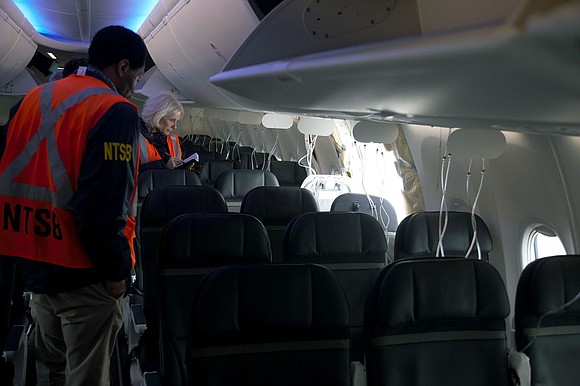Boeing’s stock tumbles after report warns investigation will open ‘new can of worms’
1/16/2024, 12:14 p.m.

Originally Published: 16 JAN 24 11:58 ET
Updated: 16 JAN 24 12:46 ET
By David Goldman, CNN
New York (CNN) — As if Boeing needed any more bad news, a scathing report from Wall Street on Tuesday sent its stock sinking sharply. The report cast doubt on Boeing’s ability to pass a new federal safety audit.
The Wells Fargo report, entitled “FAA audit opens up a whole new can of worms,” noted that Boeing’s quality control and engineering problems have been ongoing for years. After part of an Alaska Airlines] 737 Max 9 jet fell off the plane mid-flight, the likelihood of the US Federal Aviation Administration coming out of its investigation without significant findings was very low.
“Given Boeing’s recent track record, and greater incentive for the FAA to find problems, we think the odds of a clean audit are low,” the analysts said. “The FAA’s audit is limited to Max 9 for now, but it’s feasible that findings could expand the scope to other Max models sharing common parts.”
The analysts believe the investigation increases significantly the risk that Boeing takes a hit to its production and deliveries, and they downgraded the stock to “equal weight,” down from “overweight,” the equivalent of a “buy” rating.
Boeing’s (BA) stock tumbled 7% on the report.
The FAA last week opened an investigation into Boeing’s quality control after the Alaska Airlines incident. The regulator said the dramatic in-flight blowout on Alaska Airlines 1282 “should have never happened and it cannot happen again.”
The door plug, which is supposed to cover up a space left by a removed emergency exit door in the side of the plane, blew off the aircraft and left a gaping hole in the side of the plane. The force of the explosive decompression and subsequent high-speed airflow inside the cabin ripped headrests off seats as the plane flew at 16,000 feet shortly after taking off from Portland, Oregon, carrying 177 people.
Some passengers were injured, but in an extraordinary stroke of good luck, no one was seated next to the door plug, and there were no fatalities.
The FAA says the investigation will focus on whether Boeing “failed to ensure completed products conformed to its approved design and were in a condition for safe operation in compliance with FAA regulations.”
Boeing said it “will cooperate fully and transparently with the FAA and the NTSB on their investigations” in a statement last Thursday.
A week ago, Boeing CEO David Calhoun acknowledged the company’s “mistake” at a staff-wide “safety meeting,” but he did not specify what that mistake was. National Transportation Safety Board Chair Jennifer Homendy has demanded Boeing provide answers about any mistake it made as part of its safety investigation, which is separate from the FAA’s audit.
Although the investigation is ongoing, and it remains unclear what caused the door plug to blow off the plane, two airlines with a large number of 737 Max 9 planes in service — Alaska Airlines and United Airlines — said they found either loose hardware or bolts in the assembly of door plugs on their aircraft. United says its discovery pointed to possible installation issues.
In a letter to Boeing last week, the FAA gave the company 10 days to supply any information on the cause of the Alaska Airlines incident. It also wants to know what actions Boeing has taken to prevent it from happening again.
Wells Fargo analysts noted in their report that the FAA investigation could take some time to complete, noting many of its probes remain “under investigation” months after the original incidents.
All 737 Max 9 planes remain grounded as the FAA works to approve Boeing’s inspection criteria for airlines to assess the safety of the aircraft. The regulator has not provided a timeline of when the planes might return to service. Alaska and United have canceled more than 100 flights a day as they await an all-clear from the FAA.
A history of quality control problems
Boeing has faced repeated quality and safety issues with its aircraft for five years now, leading to the long-term grounding of some jets and the halt in deliveries of others.
The 737 Max’s design was found to be responsible for two fatal crashes: one in Indonesia in October 2018 and the other in Ethiopia in March 2019. Together, the two crashes killed all 346 people aboard the two flights and led to a 20-month grounding of the company’s best-selling jets, which cost it more than $21 billion.
Internal communications released during the 737 Max grounding showed one employee describing the jet as “designed by clowns, who in turn are supervised by monkeys.”
Late last month, Boeing asked airlines to inspect all of their 737 Max jets for a potential loose bolt in the rudder system after an airline discovered a potential problem with a key part on two aircraft.
Its quality and engineering problems have extended beyond the 737. Boeing also had to twice halt deliveries of its 787 Dreamliner, for about a year starting in 2021 and again in 2023, due to quality concerns cited by the FAA. And the 777 jet also suffered a grounding after an engine failure on a United flight scattered engine debris onto homes and the ground below.
Two Max variants — the Max 7 and the Max 10 — are still awaiting approval to return to the skies. This latest incident complicates that, Wells Fargo analysts noted.
“The Max 7 and Max 10 variants… are now likely to receive greater scrutiny,” they said. “This includes a required safety waiver that, while probably reasonable, looks politically difficult to grant given recent events.”
CNN’s Pete Muntean, Chris Isidore and Ramishah Maruf contributed to this report.
The-CNN-Wire



